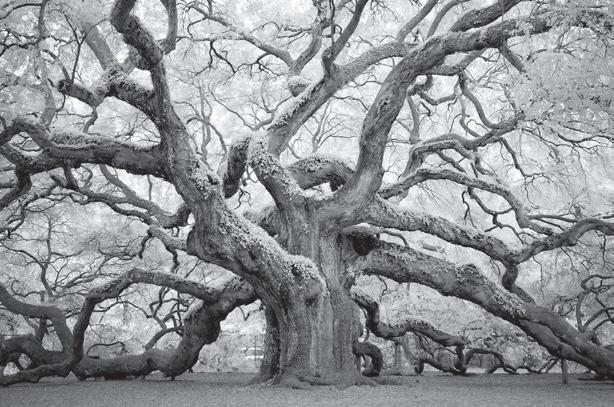
38 minute read
The Other World of Infrared Photography
Angel Oak, Johns Island, SC—This massive tree is a tourist attraction, but none the less, one of the most photogenic live oak trees in the area. It’s easy to get lost in all of the green and brown in color, but in infrared, it was easy to separate tones to truly show the spread and rhythm of this great tree. The longest branch is 180 feet long. For scale, there is a car parked to the left of the base, about 50 feet away.
The Other World
Advertisement
of Infrared Photography
I remember the first infrared image that captured my imagination. It was when I was ten years old and in the fourth grade. I saw a LIFE magazine with red palm trees on the cover. This was before Photoshop® . There was always a photo caption in those magazines. I read that the image was color infrared, which I learned renders greens as reds. Many years went by, as I didn’t get to a photography career until age 44, but I never forgot the excitement of seeing that first color infrared image.
After researching color infrared film processing, I decided to start with B&W infrared. I was set up to process B&W film and BW infrared could be processed in the same tank. It was more convenient and much easier to process (in the wet darkroom in those days).
When digital came in, it took a few years for conversion companies to begin switching out sensors to get an infrared camera. At that time, I got my first digital infrared converted, a Nikon D200.
Let’s have a look at several discussion points, infrared properties, and image examples.
Why would one choose to shoot infrared?
#1: It’s Different
The number of good photographers and outstanding images makes finding a new and exciting way to self-expression a bit daunting. It’s easy to give up, thinking that everything has been done. This is a common path to cynicism, which can be stifling to creativity and to “out of the box” thinking. Even with its growing
By Tony Sweet
Photos © Tony Sweet popularity, infrared is still in the margins. However, B&W infrared is an interesting look, different, and popular with fine art photographers and galleries.
#2: Shooting Times
A common misconception is that infrared is the domain of bright sun and trees with full green leaves. Although, it’s true that the aforementioned is a great situation, it is only one of many viable conditions. I photograph infrared at dawn/early morning, late afternoon/dusk, bright overcast/ dark overcast, in the rain, in fog, mist, midday, and during a full moon.
#3: Qualities of Light
Front light—Light source is behind you Side light—Light source 90 degrees to the right/ left Backlight—Light source is behind the subject Top light—Noon Overcast/ diffused—Soft light spreading evenly over the subject Rain—An unexpected time for infrared.
Bright overcast/ soft drizzle, and just after a storm are both excellent times for infrared. Fog—Bright/ crisp early morning fog is outstanding ••• Low angle front and side light can be quite dramatic in IR.
#4: Ethereal / Surreal Look
One of the great appeals of infrared photography is what many people refer to as the “other worldly” look. Infrared is literally re-visualizing your world.
#5: Compared to B&W Photography
Infrared can capture greater cloud detail (not visible to the naked eye), and naturally adds glow to highlights.
Hardware/ Software Conversions
You can dedicate a camera to be an infrared camera by getting an infrared filter installed by a company specializing in infrared conversions (http://kolarivision.com and http://lifepixel.com
What do the number designations mean?
• 590nm and 650nm—The lower the number (nm = nanometers) the closer to visible light spectrum and the easier to introduce color.
Advantages: ability to introduce faux color, softer blacks. • 720nm (Standard infrared)—Creates high contrast black and white infrared, yielding puffy white clouds and dark skies
Advantage: Creates high impact, black blacks and white whites.

• 830nm—Higher contrast than 720nm. Best used in flat or subdued light conditions.
Advantage: Increases contrast on low contrast days. • Full Spectrum—Basically, a clear filter is inserted in the camera allowing you to add external infrared filters on your lens to achieve any and more of the aforementioned designations: 590 filter, 650 filter, 720 filter, and 830 filter. You will have to purchase each filter separately.
NOTE: The eye piece is blacked out when using filters. Live view is essential. Recommended for mirrorless cameras.
Singh Ray 690 infrared filter—Designed to be used on a color camera to create true B&W infrared images. Note: The exposure time will be a little longer than on a converted camera.
Here’s the way it works:
All sensors have a hot mirror to block infrared for cleaner/ sharper images. However, all hot mirrors leak small quantities of infrared. It takes time to gather enough infrared leakage to create an image. Hence, a normal exposure of 1/30 sec may result in a 2 second exposure. Exposure times will vary greatly depending on the amount of light. You can raise the ISO and lower the aperture for a faster exposure using the filter. But, you will need Live View as the eye piece will be blacked out when the filter is added.
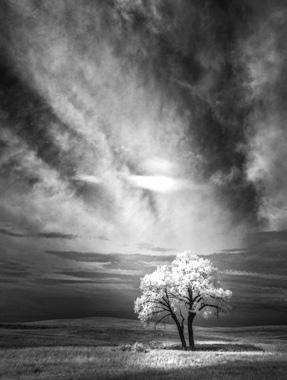
Spot light, Badlands NP, SD—A single ray of light spot lights this single cottonwood tree, the effect enhanced by the use of a radial filter, bringing out the tree and single cloud and darkening the edges.

Focusing
There is slight disparity between the normal focusing point and the infrared focusing point. Live view focusing AF is more accurate than thru the eye piece focusing. However, the disparity is small enough that stopping down to f/16 or f/22 will cover the difference. As a general practice, we focus through live view on our DSLRs.
Lenses and Hot Spots
This is a known issue and there are lists of lenses that create the hot spot, which is a bright spot (BW infrared) or a discolored spot (color infrared) in the center of your infrared image. The intensity of the hot spot can be more pronounced at higher apertures.
In addition to the list of incompatible lenses, you can easily determine if a lens creates the hot spot by taking a properly exposed image of a clear blue sky, using several different apertures. The hot spot will be visible on incompatible lenses, and not there on compatible lenses.
If you currently have images with the hot spot, it can possibly be corrected. Depending on the image, the hot spot can be fixed in many cases by adding contrast by any number of techniques: NIk’s Viveza (now owned by DxO), brush contrast in the area, try the burn tool and cloning at a very low opacity. It is a time-consuming process.
The easiest fix is to have a compatible lens.
Processing What is that red cast?
The red cast shows up on the image on back of the camera and when imported. It has no effect on the infrared image, but can be a bit distracting when viewing on the camera. If you would rather see your images in infrared on the camera, you can go into your respective camera menu and choose to view in monochrome. However, the image will still input with the color cast, which quickly goes to infrared when processed as B&W.
My Infrared Set Up
Main Camera: Nikon D800 converted to standard infrared, 720nm
Second Camera: D800 converted to 590nm, which enables introducing color into the image.
I use a Singh Ray 690 infrared filter* which has two functions:
It can be added to a color camera to create a true BW infrared. 1. Image. The exposure can be a bit longer, depending on the ambient light. However, in bright sunlight, the exposures are shorter. 2. The way that I use this filter to greatest effect is to take a color and infrared image of the same scene (tripod needed), have both images open as layers in Photoshop, then adjust the opacity. Consider masking in / out certain areas. It’s pretty much up to you at that point.
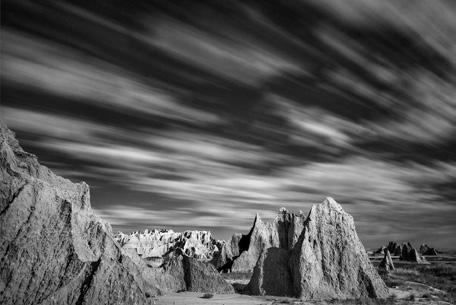
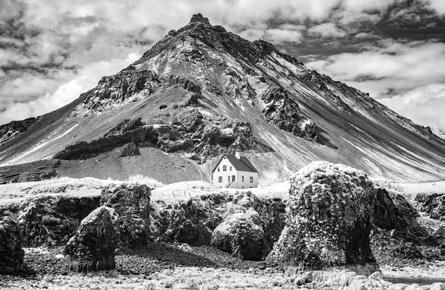
Arnistapi, Westfjords, Iceland—Photographed from the pier, this is a favorite image from this area. The low tide opens up a wonderful, large boulder foreground, lush with kelp, which renders glowing white in infrared.
Is a tripod always needed?
No, not always.
If the exposure is fast enough (shutter speed > 1/ longest focal length (e.g. for an 85mm lens, the shutter speed has to be 1/85 sec or faster (1/125 sec) to successfully hand hold the camera.
Personally, I use a tripod as a matter of course.
What camera mode to use?
It depends on what you’re used to, as all metering systems work the same in infrared.
Experiment with all modes. To get the quickest and most accurate histogram, try shooting in program mode, but you will need to remember to watch the aperture, as P mode resets to the widest

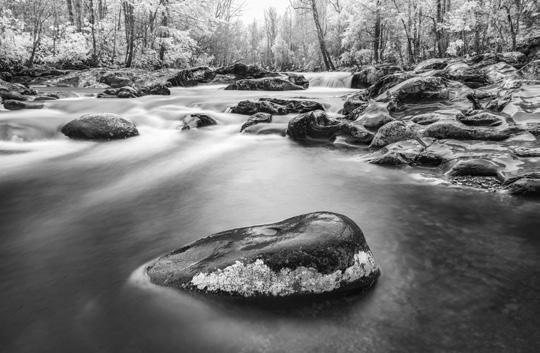
Pot Hole, Greenbriar, Great Smoky Mountains, TN—Image made during a persistent spring rain, making the rocks very dark and increasing the brilliance of the whites. Glow was added to the highlights using NikDXOs Glamour Glow filter. A 10 stop neutral density was used to slow the water.
Hill Street, Whidbey Island, WA—I added a 10 stop neutral density filter to create the 4-minute exposure. Obviously, there was no wind, which is a rare event at this location.
aperture when turning the camera off and on. I will shoot on P mode for street shooting, as things can happen quickly and taking time to set anything could result in missing a shot. I switch between Aperture priority and Program modes in all my work.
Since my first exposure to infrared as a child, I’ve developed and maintained an affinity for infrared. It wasn’t until recently that a point was reached to where hardware and software came together to help me achieve the look and feel to my work that I’ve been seeking.
Enjoy your fantastic voyage into infrared-land.
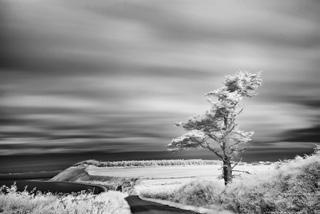
Tony Sweet
Coming from an artistic background as a professional jazz artist and professional close up magician (sleight of hand artist), Tony has always sought creative, deeply personal endeavors.
The transition from jazz artist to nature photographer was a seamless transition as both require an improvisational nature and an ability to adapt to quickly changing conditions.
Tony was named as a Nikon Legend Behind the Lens and has been published worldwide for over 35 years. He has authored 8 books, contributing to many others, co-produced an educational DVD series, and teaches and lectures throughout the US, Canada, Iceland, and Cuba.
Tony is co-owner, along with Susan Milestone, of their Visual Artistry Location Workshops Series, Creativity Seminars, and 1 ON 1 virtual training sessions and ZOOM presentations to photographic societies worldwide.
Please visit URL: http://tonysweet.com email: tony@tonysweet.com
Any mention of products or services in this article or anywhere else in the PSA Journal does not constitute an endorsement or approval of those items.
Daniel Charbonnet III, HonPSA, EPSA, HonNEC • 1943-2020
It is with great sadness that we recognize the passing of
Daniel D. R. Charbonnet III, HonPSA, EPSA,
HonNEC, of Westwood, Massachusetts for his dedication to photography at the local, national and international levels. Dan was widely respected for his long-term and far-reaching service to the photographic community, through many different services to PSA, The New England Camera Club Council (NECCC) and multiple clubs in New England.
A member of the Photographic Society of America since 1973, Dan had been an effective leader in PSA at its highest levels, including his past service as a PSA Board Member as Vice President of Exhibition Services. Dan’s service to PSA also included stints as Honors Committee member and Chairman, Chairman of the PSA International Exhibition Committee, a member of the PSA Conference equipment committee and a member of the PSA Ethics Review Board. Over the years Dan’s love of nature photography led him into many more positions in PSA’s Nature Division, including Directorships in the Slide Competitions for Individuals, Subject Identification Service, New Member Image Evaluations, and the Digital Image Interclub Competitions, which he organized and initiated. Dan had also served the Nature Division as Second and First Vice-Chair and then Chairman, where he was on a committee responsible for writing the PSA Nature definition which most of the New England clubs use today. He was part of an International Team with members from Federation Internationale de L’Art Photographique-The International Federation of Photographic Art (FIAP) and the Royal Photographic Society (United Kingdom) to develop a Common Nature Definition that all organizations could use in their nature exhibitions. At the time of his passing, he was actively engaged in the current review and updating of that definition and was assisting Roy Killen, APSA, GMPSA/B, and others with the development of a Guide for Nature judges. Dan was also actively involved with defining procedures for reviewing possible violations of the ethics standards that govern international exhibitions. Most recently Dan had taken on key roles in the Portfolios Assessment program, serving as the person who received entries, scheduled the Assessment reviews, coordinated the review process and reported back the results to those submitting portfolios. He was also part of the team working on evolving the EDAS (exhibition) reporting system toward the development of a set of databases which would enhance the reporting of exhibition results for Who’s Who and Star Ratings processing.
In recognition of his active support of PSA and his local and regional photographic organizations, Dan was elected an Associate (APSA) in 1995, a Fellow (FPSA) in 2005 and HonPSA in 2015. He received his Excellence Distinction (EPSA) for his photographic proficiency at the 2010 Conference in Charleston, where he also received the prestigious President’s Award.
Dan had an outstanding record in PSA-recognized exhibitions in four Divisions. He was a Galaxy 3 exhibitor in the Projected Image Division, a Diamond Star exhibitor in the Nature Division; a 4-Star Exhibitor in the Photo Travel Division; and a 2-Star Exhibitor in the Photojournalism Division. A much sought-after judge, he judged locally at many clubs in prints and projected images, color and nature; as well as many interclub competitions. On the national level he judged many International Exhibitions in all categories including local New England exhibitions such as the Greater Lynn Color International, the Nature Division sections of the PSA International, the Ocean State Color International, and the CamNats Nature International.
Dan’s service to the New England Camera Club Council and to photographers in the New England area was impressive and extensive as he was always willing to share his considerable general knowledge and photographic experience. Past Council president (2017-2018) and the current Chairman of the BOD, Dan served on the board of NECCC as VP for Recorded Programs VP for Recorded Commentaries and VP for the Judges & Speakers List used by many NECCC member clubs. At the NECCC conferences he was a Portfolio Reviewer for the Pre-Conference workshops for ten years and presented multiple hands-on workshops on various creative techniques as well as preconference judging workshops. In recognition of his support and service to NECCC and its member clubs, Dan was elected MNEC (1985) and HonNEC (2018) and had the annual NECCC Conference dedicated to him in 2016.
Dan was also a member and past president of the Massachusetts Camera Naturalists (CamNats -MA) and a past president of the Boston Camera Club (MA) and the Stony Brook Camera Club (MA). He was a member of Greater Lynn Photographic Association (GLPA-MA) where he competed in their Masters Class and an honorary member of the Photographic Society of Rhode Island (PSRI) where he served as a technical advisor of the Ocean State International Exhibition.
Dan demonstrated that he was an innovative problem solver, an effective and authoritative communicator who was always thoroughly prepared, and a tireless worker with remarkable attention to detail. He made significant and long-lasting contributions to the photographic community in all these pursuits and endeavors and will be dearly
missed by the local clubs as a judge and commentator.
He will be dearly missed as a leader, photographer and a friend. Submitted by Susan Mosser,
HonPSA, HonNEC Shiv Verma, FPSA, MNEC
Nancy Sams, FPSA, EPSA, AFIAP
It is with a sad heart we announce the passing of Nancy Sams. Nancy played a significant role in both Minneapolis and Phoenix photography. She taught art history and photography at Lowthian College (1976-1993). She was President of the Woman’s Color Photo Club, Chairman of the Twin City Area Council of Camera Clubs (TCACCC) and Chairman of the Minneapolis-St Paul International. In 1994, Nancy received the TCACCC Distinguished Fellow Award.
In Arizona, she had been President of the Saguaro Camera Club, President of the Arizona Council of Camera Cubs (ACCC), Co-founder of the Grand Canyon International. Nancy was an early adopter of digital photography and founded the Arizona Photographic Society to teach digital photography and started the Arizona International exhibition (EID), one of the first PSA/FIAP exhibitions in the US. She received her AFIAP in 1995. She was awarded an ACCC Honorary Fellow in 2008.
Nancy joined PSA in 1987. She was proud of having achieved a fivestar rating in every division except 3D. She achieved PPSA in 1997 and EPSA in 2005. She was a leader in the photographic circles and was known for her teaching, lecturers, judging and leading many photographic trips and workshops. She contributed to the PSA Journal, receiving a second Silver Star in 2006. Nancy served as Who’s Who Director for Large Color Prints and Regional Director (RD) for region 20. For all of her years of dedication to PSA and photography, she was awarded APSA in 1997 and FPSA in 2007. Nancy’s leadership and willingness to help others will be missed by those that knew her.
Submitted by Larry Cowles, HonPSA,
GMPSA/P, EFIAP/d1
on several committees including the PSA Nominating Committee 1998-2001. He received a PSA Bronze Editorial Award in 2011 and PSA Service Award in 2012, active in Slide Study Group #53, Director of Slide Study Sets, Director of American Portfolios and treasurer of Color Slide Division. Jim was awarded APSA in 1998 and FPSA in 2015.
Locally, Jim was Chairman of the Evergreen PSA International, he served on the BOD of the NWCCC and Chairman of the PSA Chapter receiving the PSA Harold D. Lorimore Memorial Award and the NWCCC Progress Award. He was a member of the Olympic Peaks CC and served in most all the offices the club had. In 2011 they honored Jim with their 1st OPCC Award of Honor and Lifetime Honorary Membership.
While Jim enjoyed entering contests and competitions, he judged many photo contests both local and for PSA, conducted workshops and programs, always inspiring others with their own photography. His infectious enthusiasm inspired many to join PSA! Jim will always be remembered as a true gentleman and missed by Irma and so many photography friends.
James (Jim) R. Martin FPSA Jim Martin,
FPSA, of Sequim, Washington passed away on Nov. 28, 2020 due to heart failure. He was 92. Originally from St. Louis, Missouri and a proud member of St. Louis Camera Club 1987–90; Jim relocated after retirement to the Pacific N.W. with his loving wife Irma.
After joining PSA in 1991. Jim served
PSA Journal Replacement Policy
If a member has not received a PSA Journal mailing, PSA Headquarters should be notified within three months of the month of the issue (ex. July Journal can be requested through the end of September). Any request for Journals following the three month period will only be accepted if the issue is available and if the request is approved. PSA may instruct that the missing issue(s) can only be viewed online. PSA has the right to refuse Journal requests due to quantity requested or issue availability. Furthermore, replacement Journals should be limited to three replacements per year and the member should contact their local postal system for a resolution. Submitted by
Steven Fisher FPSA, GMPSA
Rev. Dr. Frederick Seyfert
The Rev. Dr. Frederick Seyfert, a 23-year PSA member, passed away on November 15 at age 93. A 46-year member of Delaware Photographic Society, he and his late wife JoAnn had been awarded complimentary membership in recognition of their extensive involvement, and he continued to judge and attend meetings until last year. He was a salon level slide and printmaker, as well as a frequent model for portrait sessions and workshops, and is remembered for his friendly manner and sense of humor. Over several decades, he spent most weekends at Ft. Delaware, educating the public through live interpretation of the Rev. Isaac Handy, who had been a political prisoner there during the Civil War. A lifelong quest for knowledge led to multiple graduate degrees, worldwide travel and a love of teaching, particularly history and photography at the University of Delaware Osher Institute.
Submitted by Lynn Troy Maniscalco,
HonFPSA, EPSA
Star Ratings
n Projected Image Division
Color Class (PIDC)
Compiled by Vicki Moritz, GMPSA;
Jenni Horsnell, GMPSA/s, EFIAP;
Achinta Kumar Saha, APSA, GMPSA, and Rajdeep Biswas, GMPSA, EFIAP
Diamond 5
Xiaomei Xu, GMPSA/S, SPSA, China
Diamond 1
David Poey Cher Tay, APSA, GMPSA,
Singapore
Galaxy 6
Bob Devine, MPSA2, England Sara Gabriëls, MPSA, Belgium
Galaxy 5
J.R. Schnelzer, FPSA, MPSA, USA Wally Cannon, MPSA2, Australia
Galaxy 4
Massimo Tommi, MPSA, Italy Sharifa Khatri, MPSA, India
Galaxy 3
Janos Eifert, EPSA, Hungary Massimo Tommi, MPSA, Italy
Galaxy 1
Anitha Mysore, EPSA, India Ratnajit Choudhury, MPSA, India Romos Kotsonis, PPSA, Cyprus Valentina Sokolskaya, APSA, EPSA, USA
Star 5
Mousumi Sarkar, EPSA, India Udayan Sankar Pal, EPSA, India Valentina Sokolskaya APSA EPSA, USA
Star 4
Eric Weytens, QPSA, Belgium Mohammad Awadh, Kuwait Mustafa Evirgen, Cyprus Song Chuan Tan, PPSA, Malaysia Yiping Xu, PPSA, Australia
Star 3
Andreas Ierides, QPSA, Cyprus Fran McFadzen, QPSA, Australia Gajanana Pandit, India Mohammad Awadh, Kuwait Mustafa Evirgen, Cyprus Piu Maitra, India Prabir Kumar Roy, India
Star 2
Andreas Ierides, QPSA, Cyprus Gianni Martini, QPSA, Italy Pranab Sarkar, India Marcia Marchetto QPSA, Brazil Mohammad Awadh, Kuwait Mustafa Evirgen, Cyprus Raymond-Paul Zurschmitten, QPSA,
Switzerland Xrysa Marketaki, QPSA, Greece
Star 1
An Nguyen, QPSA, USA Andreas Ierides, QPSA, Cyprus Dee Darius Sams, USA Mohammad Awadh, Kuwait Mustafa Evirgen, Cyprus Pat Couder, England Samrat Ghosh, QPSA, India Shirley Hai Trinh, QPSA, USA Xrysa Marketaki, QPSA, Greece
Diamond 1
Gunther Riehle, APSA, GMPSA/P,
Germany
n Projected Image Division
Monochrome Class (PIDM)
Compiled by Elizabeth Passuello, EPSA,
EFIAP; Graham Harris, PPSA, AFIAP; Steven Stavri, PPSA, AFIAP; Asok Samaddar, EPSA, EFIAP
Galaxy 8
Xiaomei Xu, GMPSA/S, SPSA, China
Galaxy 6
Vicki Moritz, GMPSA, Australia
Galaxy 4
Jef Lemmens, GMPSA/B, Belgium Pandula Bandara, MPSA2, Sri Lanka
Galaxy 2
Asim Kumar Chaudhuri, MPSA, India J.R. Schnelzer, FPSA, EPSA, USA
Galaxy 1
Asim Kumar Chaudhuri, MPSA, India Cyril Boyd, EPSA, Northern Ireland J.R. Schnelzer, FPSA, EPSA, USA
Star 5
Hong-Sang Woo, APSA, MPSA, Malaysia Piyali Mitra, MPSA, India Yuet Yee Wong, EPSA, Hong Kong Yuri Shepelev, PPSA, Israel
Star 4
Basudeb Chakraborty, EPSA, India Cho Mar Htun, PPSA, BPSA, Singapore Kay Scheibner, PPSA, Germany Manu Reghurajan, GPSA, United Arab
Emirates Minh Nguyen, PPSA, USA Song Chuan Tan, PPSA, Malaysia Steven Stavri, PPSA, Cyprus
Star 3
Manu Reghurajan, GPSA, United Arab
Emirates Song Chuan Tan, PPSA, Malaysia Steven Stavri, PPSA, Cyprus Yao Zu Shu, Australia Yiping Xu, PPSA, Australia
Star 2
David Cowsill, QPSA, England Eszter Emese Lazar, QPSA, Greece Manu Reghurajan, GPSA, United Arab
Emirates Nilendu Banerjee, India Piu Maitra, India Prabir Kumar Roy, India Yao Zu Shu, Australia Yiping Xu, PPSA, Australia
Star 1
Ladislav Pollak, QPSA, Slovakia Manu Reghurajan, GPSA, United Arab
Emirates Nilendu Banerjee, India Pat Couder, England Piu Maitra, India Ruediger Schulz, Germany Xrysa Marketaki, Greece Yao Zu Shu, QPSA, Australia Yiping Xu, Australia
Compiled by Jenni Horsnell, GMPSA/S,
EFIAP; Vi Wilson, MPSA
Diamond 10
Jenni Horsnell, GMPSA/S, Australia
Diamond 2
Jhony Vandebroeck, MPSA, Belgium
Galaxy 9
Xiaomei Xu, GMPSA/S, SPSA, China
Galaxy 8
Xiaomei Xu, GMPSA/S, SPSA, China
Galaxy 5
Rene Van Echelpoel, PPSA, Belgium Robin Luo, MPSA2, Canada
Galaxy 4
Margaret Boike, APSA, MPSA, USA Rene Van Echelpoel, PPSA, Belgium
Galaxy 3
Rene Van Echelpoel, PPSA, Belgium
Galaxy 2
Frank Hausdoerfer, MPSA, Germany Rene Van Echelpoel, PPSA, Belgium
Galaxy 1
Barbara Schmidt, MPSA2, Germany Frank Hausdoerfer, MPSA, Germany Klaus Schwinges, MPSA, Germany Ratnajit Choudhury, MPSA, India
Star 5
Asim Kumar Chaudhuri, MPSA, India Barun K Sinha, India Frank Hausdoerfer, MPSA, Germany Irene Kramer, EPSA, USA Jeffrey William Venning, EPSA, Australia Kwok Keung Cyril Leung, MPSA,
Hong Kong
Star 4
Asim Kumar Chaudhuri, MPSA, India George Baladakis, QPSA, Greece Loretta Yat Wong, GMPSA, SPSA,
Hong Kong Billion Lim, EPSA, Malaysia Borislav Milovanovic, EPSA Serbia Inge Vautrin, PPSA, USA Yuk Fung Garius Hung, PPSA, Hong Kong
Star 3
Asim Kumar Chaudhuri, MPSA, India Boo Sum Robert Choy, PPSA, Hong Kong George Baladakis, QPSA, Greece Hans-Werner Griepentrog, PPSA, Germany Judy Smith, QPSA, England Loretta Yat Wong, GMPSA, SPSA,
Hong Kong Yuk Fung Garius Hung, PPSA,
Hong Kong
Star 2
Asim Kumar Chaudhuri, MPSA, India Boo Sum Robert Choy, PPSA, Hong Kong Claire Sullivan, Ireland Fran McFadzen, QPSA, Australia George Baladakis, QPSA, Greece Loretta Yat Wong, GMPSA, SPSA,
Hong Kong Mohammad Awadh, Kuwait Raymond Zurschmitten, QPSA,
Switzerland Vinod Kumar Kulkarni, India Yuk Fung Garius Hung, PPSA, Hong Kong
Star 1
Asim Kumar Chaudhuri, MPSA, India Boo Sum Robert Choy, PPSA, Hong Kong Fran McFadzen, QPSA, Australia George Baladakis, QPSA, Greece Loretta Yat Wong, GMPSA, SPSA,
Hong Kong Mohammad Awadh, Kuwait Raymond Zurschmitten, QPSA,
Switzerland Samrat Ghosh, QPSA, India Yuk Fung Garius Hung, PPSA, Hong Kong
n Photo Travel Division
Compiled by Steven Yee Pui Chung, GPSA,
ESFIAP; Amy Pang Lai Man; Pandula Bandara, MPSA2; Suvojit Biswas, MPSA
Galaxy 8
Xiaomei Xu, GMPSA/S, SPSA, China
Galaxy 6
Miranda Siu, GMPSA, Canada
Galaxy 5
Sharifa Khatri, MPSA, India David Tay Poey Cher, , APSA, GMPSA,
Singapore
Galaxy 4
Barbara Schmidt, MPSA2, Germany
Galaxy 3
Kostas Chalkiadakis, MPSA2, BPSA,
Greece
Galaxy 2
Binyuan Li, EPSA, China
Galaxy 1
Anitha Mysore, EPSA, India Piyali Mitra, MPSA, India Ratnajit Choudhury, MPSA, India J.R. Schnelzer, FPSA, EPSA, USA
Star 5
J.R. Schnelzer, FPSA, EPSA, USA Mingwei Chen, PPSA, China Asim Kumar Chaudhuri, MPSA, India Dr. Iris Baehren, MPSA, Germany
Star 4
Tan Song Chuan, Malaysia Asim Kumar Chaudhuri, MPSA, India Cho Mar Htun, PPSA, BPSA, Singapore Mousumi Sarkar, EPSA, India Romos Kotsonis, EPSA, Cyprus Thanasis Hadjipavlou, EPSA, Cyprus David Price, EPSA, UK
Star 3
Steven Stavri, PPSA, Cyprus Minh Le, QPSA, USA Tan Song Chuan, PPSA, Malaysia Asim Kumar Chaudhuri, MPSA, India Mousumi Sarkar, EPSA, India
Star 2
Daniel De Cort, Belgium Fran McFadzen, QPSA, Australia Potse Chen, Taiwan Marcia Marchetto, QPSA, Brazil Yvonne Moule, PPSA, Australia Judy Smith, QPSA, England Asim Kumar Chaudhuri, MPSA, India Pranab Sarkar, India Mousumi Sarkar, EPSA, India Kumaraswamy Anjanappa, India
Star 1
Claire Sullivan, Ireland Potse Chen, Taiwan An Nguyen, QPSA, USA Wei Loon Lim, Malaysia Judy Smith, QPSA, England Asim Kumar Chaudhuri, MPSA, India Mousumi Sarkar, EPSA, India Saw Minn Naung, QPSA, Myanmar
Galaxy 8
Ekkehard Retelsdorf, GMPSA, Germany
Star 5
Jan Romanowski, EPSA, Germany Klaus Schwinges, MPSA, Germany
n Photojournalism Division
Compiled by Craig Parker, MPSA, BPSA,
EFIAP/b
Star 4
Asim Kumar Chaudhuri, MPSA, India Miranda Siu, GMPSA, Canada
Star 3
Asim Kumar Chaudhuri, MPSA, India Miranda Siu, GMPSA, Canada Soham Sarkar, EPSA, India Steven Stavri, PPSA, Cyprus
Star 2
Asim Kumar Chaudhuri, MPSA, India David Price, EPSA, England Joyraj Samanta, EPSA, India Kai Hay Clement Law, PPSA, Hong Kong Mahesh Kumar Viswanadha, India Miranda Siu, GMPSA, Canada Soham Sarkar, EPSA, India
Star 1
Asim Kumar Chaudhuri, MPSA, India David Price, EPSA, England Fran McFadzen, QPSA, Australia Joyraj Samanta, EPSA, India Mahesh Kumar Viswanadha, India Miranda Siu, GMPSA, Canada Potse Chen, Taiwan Samrat Ghosh, QPSA, India Soham Sarkar, EPSA, India Wei Loon Lim, QPSA, Malaysia
n Pictorial Print Division
Color Prints Large and Small Mixed
Compiled by Wolfgang Lin, MPSA2, SPSA
Star 4
J.R. Schnelzer, FPSA, MPSA, USA
Star 3 J.R. Schnelzer, FPSA, MPSA, USA
Star 1
Wim Moortgat, EPSA, Belgium Wade Buchan, QPSA, Australia Soham Sarkar, India Jean Boulanger, EPSA, France
n Pictorial Print Division
Mono Prints Large and Small Mixed
Compiled by Wolfgang Lin, MPSA2, SPSA
Galaxy 5
Barbara Jenkin, GMPSA/G, SPSA,
England
Star 4
J.R. Schnelzer, FPSA, MPSA, USA
Star 3
J.R. Schnelzer, FPSA, MPSA, USA
Star 2
J.R. Schnelzer, FPSA, MPSA, USA
Star 1
Ken Weaver, EPSA, USA Wim Moortgat, EPSA, Belgium J.R. Schnelzer, FPSA, MPSA, USA Soham Sarkar, India Jean Boulanger, EPSA, France
n 3D
Compiled by Eugene Mitofsky,
APSA, PPSA
Master 5
Geoff Peters, APSA, PPSA, USA
Enter an Exhibition
Exhibitions, formerly called Salons, offer an opportunity for photographers to exhibit their work with other photographers from around the world. Images that are accepted into exhibitions can be used to earn Star Ratings and ultimately PSA ROPA distinctions. • Anyone can enter an International Exhibition of Photography. • A single entry is typically four images. • Apart from 3D exhibitions, the maximum acceptance rate for
PSA only exhibitions is 35%. The recommended, not compulsory minimum acceptance rate is about 20%. However, those PSA exhibitions which also have FIAP patronage have a maximum acceptance rate of 25% • Find an exhibition from the Current Exhibition List • Choose “Enter an Exhibition” from the left panel for more information
Find the current exhibitions lists on the PSA website: https://psa-photo.org/index.php?exhibitions-current-exhibition-list
PSA Logo Masks
We have PSA logo masks available for members to order. The masks are 100% cotton and machine washable and ready to use for your protection. The masks are available in red or black and are only $10.00 each plus shipping. The shipping rates are $5.00 in USA and $20.00 for shipping outside of the USA.
We will offer shipping discounts for bulk orders.
Once you order you will receive an invoice by email from PSA PayPal. You can pay invoice by PayPal, debit or credit card. Once payment is received it will ship from headquarters.
Place your order at this link: https://psa-photo.org/index. php?psa-masks
365-Day Challenge
Larry Cowles, HonPSA, GMPSA/P, EFIAP/d1 For several years the PSA Journal published the 365-Day Challenge directed by Dennis Hirning, FPSA, MPSA. While no longer appearing in the Journal, the project still exists. This PSA offering is a great way to practice your photography. By having a subject to photograph everyday it motivates you to pick up the camera and gives you a goal. It teaches you to open your eyes and look for subjects to photograph. It also gets you out of the rut of photographing what you are comfortable with. Daily assignments are provided to keep the gallery inspired and interesting. You can view the current assignments at https://psa-photo.org/index. php?365-day-gallery and see examples. Questions can be directed to Dennis at 365-director@psa-photo.org.
DIVISION NEWS, ACTIVITIES AND ANNOUNCEMENTS
If you have an item of national or international interest concerning a PSA activity that you wish to appear in the news, please email a brief article to the appropriate News Editor. General News/Calendar of Events items can be emailed to the Journal Editor at editor@psa-photo.org.
Abbreviations used in these columns (no periods after letters): CC = Camera Club PA = Photographic Association PS = Photo Society PC = Photo Club PG = Photo Guild PGr= Photo Group (All others spelled out)
Information about divisions can be found on the PSA Website www.psa-photo.org
Photo Travel (PTD)
Lynn Troy Maniscalco, HonFPSA, EPSA, Editor, Ltmphoto@juno.com
InterClub Competition
Round 1 finished with Delaware PS in the lead in Class A, followed closely by Saguaro CC and St. Louis CC. The top scoring images were Aurora over Ersfjordbotn by Temu Nana of Delaware PS and Reaching for the Sky Mountains by Dick Roman of St. Louis CC. Shirley Bormann, APSA, EPSA, was the coordinator for the host club, Grand Photos, and the judges were Stan Bormann, FPSA, MPSA, Judy Helderman and Sheldon Wecker,
QPSA.
In Class B there was a tie for the lead between Australia’s Belmont 16s PC and Saudi Arabia’s New View PC, with Lehigh Valley CC coming in third. The top scoring image was Desert Flower by Juma Aljaafari of New View PC. Diana Magor, APSA, MPSA was the coordinator for the host club, Hoylake PS, and the judges were Lyn Rostron, Noel George and Sue Freeman.
The second round of entries, six images per club, are due on February 15. For questions, contact the division I-C director Suniel Marathe, GMPSA.

Class A—Aurora over Ersfjordbotn © Temu Nana

Class B—Palais des Arts Hemishperic © David Braitsch
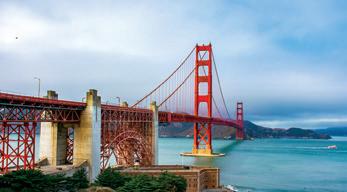

Botswana Leopard © Steve Hughes
3D (3DD)
Lynn Troy Maniscalco, HonFPSA, EPSA, Editor, Ltmphoto@juno.com
3D Interclub Competition
Suzanne Hughes, APSA, Director ISCC, announced the club standings and cumulative points after the first round. 1 - 69 points, Sydney Stereo CC 2 - 67 points, Georgia-3D 3 - 63 points, Ohio Stereo PS 4 - 61 points, LA 3-D Club 5 - 55 points, Cascade Stereoscopic Club 6 - 51 points, Puget Sound Stereo CC
Detroit Stereographic Society hosted and will enter make-up images in another round. The club reps Dennis Hanser and Rick Shomsky managed the judging. The jury, Dennis Green, APSA. PPSA; Steve Kiesling and Lindel Salow. Below are the top individual winners. 1st—Bombo Quarry by Mark Brennan,
Sydney Stereo Camera Club 2nd—Botswana Leopard by Steve
Hughes, Georgia-3D 3rd—Locked Shed by Jim Metcalfe,
Sydney Stereo Camera Club 4th—Crater Lake, Oregon by Lee Pratt,
HonPSA, Georgia-3D
The next round is due February 15, 2021, and Puget Sound Stereo Camera Club will be hosting.
Annual Nonstar Competition
Girl and Crepes by Howard Michelsen was the winner of the 2020 Individual Nonstar Competition, a free annual PSA activity run by Potomac Society of Stereo Photographers for PSA members with fewer than 18 exhibition acceptances. According to the director, Jim Roy, FPSA, PPSA, there were 20 digital entries judged on October 17 by Robert Leonard, HonPSA, FPSA, Master 8; Geoff Peters, APSA, PPSA, Master 4, and Jonathan Orovitz, threetime Nonstar winner.
Jim said Howard’s heavily European subjects also included Bird, Savage Machine, and Los Tres Amigos, Spanish mountaineers. Second place was awarded to NYC 3D, a night aerial of Manhattan by Andrew Parke, who also entered Alps Aerial, Experimental Dance—Bondage, and Hurricane Wear, a texture study of weathered wooden docks. In third place was Monarch Cat(erpillar) by Ursula Drinko, whose other entries were Fog Over the Valley, a bridge scene, Contemplation, and Yellow Man, a snow scene with footbridge. David An went to Florida, taking Flying Shamu, Flying Dolphin, Sync Dancing, and Giant Tortoise, an underwater view, and Harry Chow had mostly biplanes at a nearby airshow: N725AM, Last Minute Inspection, Proud Owner, and Colonial Sisters. Sammy Somekh, FPSA, EFIAP/b Editor, sammysomekh@hotmail.com
Photojournalism Definition
February 2020, the lights were dimming rapidly and soon, an eerie darkness would shroud the entire globe. But February 2021 hopefully sees us at the exit end of the tunnel, heralding hope and happiness and a gradual return to normal. So, let us rev up our photo gear and remember what the Photojournalism Definition, approved last May, is all about:
“Photojournalism entries are images with informative content and emotional impact, reflecting the human presence in our world. The journalistic (story-telling) value of the image should receive priority over pictorial quality. Images that misrepresent the truth, such as those from events or activities arranged specifically for photography, or of subjects directed or hired for photography, are not eligible.
Techniques that add, relocate, replace, remove or change any element in the original scene, except by cropping, are not permitted. All images must look natural. The only allowable modifications are removal of dust, scratches or digital noise and restoration of the appearance of the existing scene, or complete conversion to grayscale monochrome. Other derivations, including infrared, are not eligible.
Human Interest images depict a person or persons in an interactive, emotional, or unusual situation, excluding recreational or sports action.”
Actually, the second paragraph is universal for reality divisions, while the third paragraph applies whenever Human Interest is indicated for a dedicated medal or a separate section.
Good luck with the winning images!

Clubs and Council
Lynn Troy Maniscalco, HonFPSA, EPSA, Editor, Ltmphoto@juno.com
Safe Participation
The major activity of one PSA member club, Long Island Photo Gallery, involves frequent gallery shows. During
a lockdown they held a virtual opening reception, but when COVID cases decreased, they decided to return to their traditional format for the next exhibit, with the following restrictions for the opening reception and visits to view the exhibit.
We will be observing NY state guidelines for COVID mitigation. Please do your part. No food or beverage will be provided, but you are welcome to bring your own. Anything that you bring into the gallery must be carried out.
An increase in COVID cases may require a return to virtual receptions. There is no way to know what the situation will be by the time this appears in print, but if your group has come up with a new way to keep going, please share it by sending to the address at the top of the column.
International
Agatha Bunanta, FPSA, GMPSA, GPSA, EFIAP/p, Editor • IRVP@psa-photo.org
Tirta Dasgupta, FPSA, welcomed participants to the Zoom webinar. Photo by Mukesh Srivastava, EFIAP.
Agatha Bunanta, FPSA, GMPSA, GPSA,
EFIAP/p, presented Indonesia Beauty in Frame. Photo by Tirta Dasgupta, FPSA.
Zoom Webinars
On November 17, 2020, the School of Fototechnik, a PSA Club member, led by Tirtha Dasgupta, FPSA, PSA Membership Director for India, with cooperation from Shikhar Explorer’s Club, organized a Zoom webinar with a Guest Speaker, Agatha Bunanta, FPSA, GMPSA, GPSA, EFIAP/p, PSA International Relationships VP. Agatha presented Indonesia Beauty in Frame, a collection of Indonesia Photos in various locations in Indonesia. More than 70 participants participated in this Zoom webinar, including Nan Carder, FPSA, GMPSA, PSA Secretary; Andrew Hayes PPSA, EFIAP/s, PSA Membership Vice President; and Ioannis
Lykouris MFIAP, HonEFIAP, FIAP
Secretary General.
On December 12, 2020, Vickum Senanayake, QPSA, PSA Liaison Officer, Membership Director and Translation Service Director, organized a PSA Zoom webinar for Sri Lanka photographers, together with Pandula Bandara, MPSA2, The PSA Travel Star Ratings Director and PSA Regional Exhibition Standards Director Region 6.
The presentation covered an introduction to the Photographic Society of America, ROPA and Portfolio Distinctions.
This presentation was attended by more than 50 participants, including the PSA International Relationships VP,
Agatha Bunanta, FPSA, GMPSA,
GPSA, EFIAP/p.

Vickum Senanayake, QPSA, presented the introduction of Portfolio Distinctions. Photo by Pandula Bandara, MPSA2.

Pandula Bandara, MPSA2, explains PSA Exhibitions on the PSA website. Photo by Pandula Bandara, MPSA2. 44 • PSA Journal • February 2021 • www.psa-photo.org
Photographic Alliance of America (PAA)
By Joanne Stolte, HonPSA, MPSA, EFIAP, ESFIAP President, Photographic Alliance of America • FIAP Liaison Officer for the United States of America
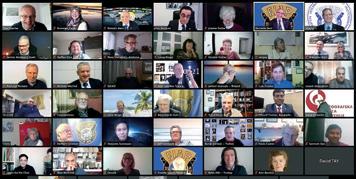
Some of the 2020 FIAP General Assembly Attendees
FIAP Holds 2020 Annual General Assembly via Videoconference
On Saturday, December 19, 2020, the International Federation of Photographic Art (FIAP) held its 2020 Annual General Assembly via Zoom Videoconference. The FIAP General Assembly is the formal meeting where official business is conducted and it meets once a year between August and December, every other year which is during the FIAP Congress. In 2019 the FIAP General Assembly was held in Spokane, WA, during the PSA Photo Festival and this year the General Assembly would have been held during the FIAP Congress, which had to be canceled.
The attendees were located in various time zones around the world. For example, the FIAP Liaison Officer for Australia, Bronwen Casey, lives in Melbourne and the meeting began at 1:00am Sunday morning for her. The PAA President and FIAP Liaison Officer for the USA,
Joanne Stolte, HonPSA, MPSA, EFIAP,
ESFIAP, attended beginning at 6:00am Saturday, December 19.
The 2020 General Assembly was called to order by FIAP President, Riccardo Busi, QPSA. Following a delineation of the year’s activities, Riccardo turned the meeting over to FIAP General Secretary, Ioannis Lykouris, who performed a role call of each member country. FIAP country Liaison Officers submitted their credentials prior to the meeting in order to vote. Following the General Assembly each credentialed Liaison Officer submitted their completed ballot via email.
FIAP Treasurer, Kurt Batschinski, then provided a review of the present FIAP financial status and suggested two auditors for the next audit.
As the 2020 General Assembly came to a close everyone waved goodbye and lingered to see their photo friends as they signed off. The regret of not meeting in person and sharing hugs was most apparent.
FIAP Treasurer Kurt Batschinski reviewing FIAP Finances
• For information regarding the
Photographic Alliance of America (PAA): https://psa-photo.org/index. php?paa • Like PAA on Facebook: https://www. facebook.com/Photographic-Allianceof-America-1986883941590941/.
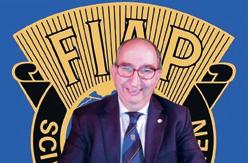
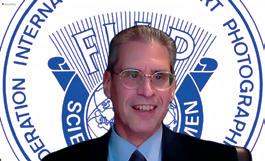
PSA Study Groups
A Benefit of Membership
Tregaron Frog by Lisa Auerbach Group 52 Nature Plus.

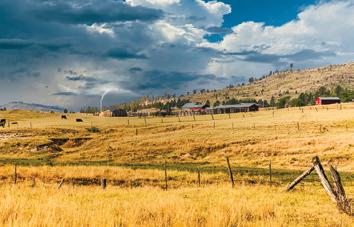
Approaching Storm by Kurtis Sutley Group 38 General
Study groups are small groups of photographers, from all experience levels (beginner to pro), who share an interest in a particular type of photography, such as nature, monochrome, macro, etc.
What is being studied? Other members’ images that the makers are looking for help with—images that have not received awards or exhibition rankings. Study groups are not meant to be a showcase of our celebrated works.
When it comes to our own photography, we sometimes become blind to the things that hold an image back. A study group provides a safe place to get helpful feedback from others. They’re also a great place to meet others who share a common interest and whose insights can help you quickly progress in your photography.
Images are submitted on a regular basis and, once they are online, other members critique (and sometimes score) each image, offering tips and techniques to capture the image better and/or post-process the photo and, in some cases, demonstrate the process described on that image. Some study groups provide specially trained commentators who will furnish their critiques as well. We have study groups for those who prefer to work on their images in private and study groups that are completely public for the benefit of member and visitor alike.
PSA membership is required for
participation in any Study Group. You’re free to join as many different groups as is practical to add to your schedule. There is a great variety of topics and image formats, as well as a variation in how each Study Group is administered. To find the right group for you, look through all the opportunities and contact the Study Group Director(s) so you can make an informed decision.
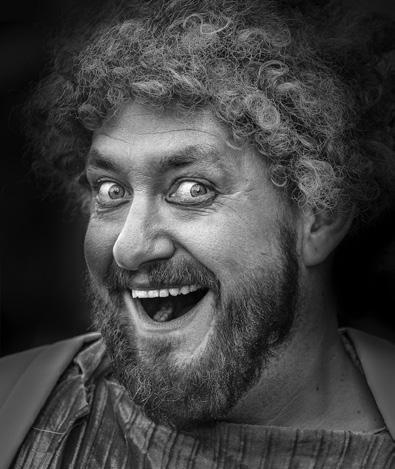
David Price, EPSA, of Cockermouth, Cumbria, England wins with his First Place Star Mono print Antigonious. This month’s judge, Tom Hady, APSA, MPSA, tells us why: “Recently, I saw a quotation attributed to Edward Steichen, “A portrait is not made in the camera but on both sides of it.” This image is a good example. David Price used the tools well. The photo is sharp, the exposure brings out full tonality, and the lighting makes the face seem threedimensional. On the other side of the camera, we get the feeling that we know something of the personality of the young man. He seems to be a happy person, perhaps inclined to clown a bit. He’s someone we might like to meet.”
To view the POM gallery, go to https://psa-photo.org/index.php?2020-21-ppd-pom-oct-pom
To participate in future Pictorial Print of the Month contests go to http://www.psa-photo.org/index.php?divisions-pictorial-prints-print-of-the-month
Assist PSA by Using AmazonSmile
What is AmazonSmile? AmazonSmile is a simple and automatic way for you to support the Photographic Society of America every time you shop, at no cost to you. When you shop at smile.amazon.com, you’ll enjoy the same low prices, vast selection and convenient shopping experience as Amazon.com, with the added bonus that Amazon will donate a portion of the purchase price to PSA.
On your first visit to AmazonSmile smile.amazon.com, you need to select the Photographic Society of America to receive donations from eligible purchases before you begin shopping. Amazon will remember your selection, and then every eligible purchase you make at smile.amazon.com will result in a donation.
You can use the same account on Amazon.com and AmazonSmile. Your shopping cart, wish list, wedding or baby registry, and other account settings will be the same.
Thank you for your support.
Stay Connected with PSA Anywhere in the World…
While on the go or at your home computer

www.psa-photo.org
• Learn more about PSA • Get the latest PSA news • Read the PSA Journal online • Have images evaluated • Register for an activity • Take an online photography course • Work with a Mentor • Participate in activities (Study Groups) • Access a service (Species Identification) • Find Exhibition Listings ® • Enter images for competition • Get advice from a Consultant • Reference information (Member
Discounts) • View slide shows (Interclub Galleries) • Upload images for your gallery • See award-winning images • Watch videos (Conference photo ops)
For assistance or comments concerning the website, contact webmaster@psa-photo.org
Photographic Society of America • 8241 S. Walker Ave., Suite 104, Oklahoma City, OK 73139 (405) 843-1437 • Toll Free: 855-772-4636 (855-PSA-INFO)







